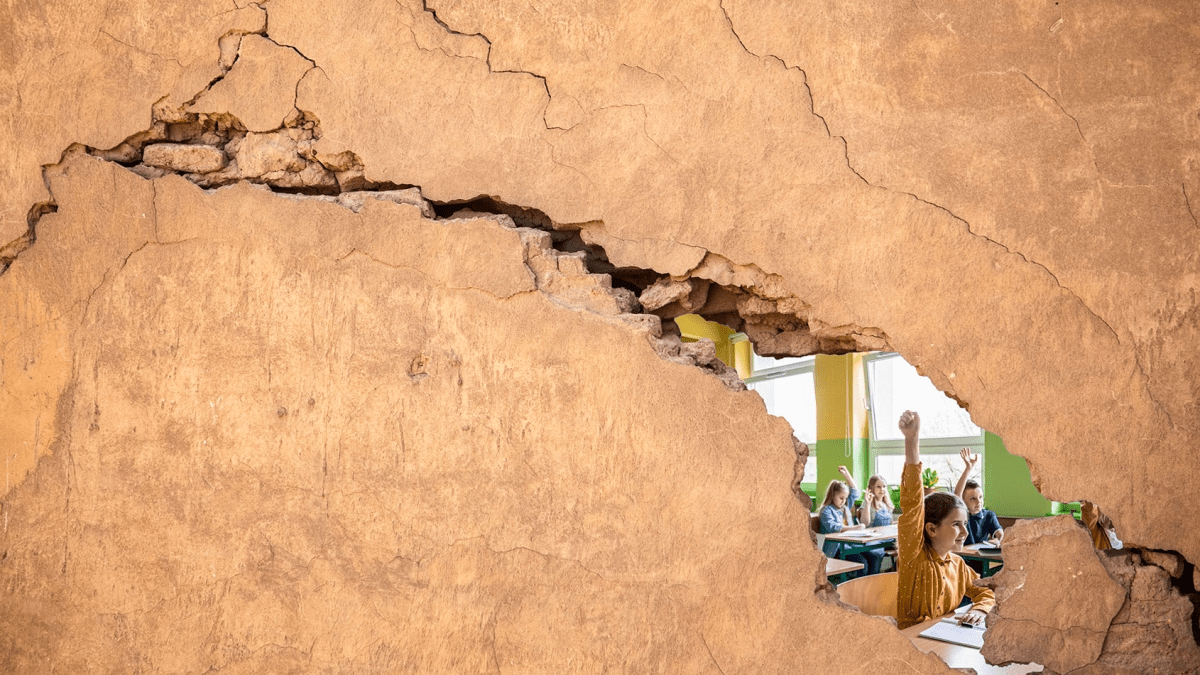Last week, ministers ordered schools to immediately shut down buildings made with aerated concrete until safety work is undertaken. The decision could see thousands of pupils begin out of school until the autumn term. Although this is a recent issue within an Education setting, Procure Partnerships have been supporting healthcare clients with RAAC issues for the past six years.
Reinforced Autoclaved Aerated Concrete (RAAC) has gained popularity over the years for its lightweight and energy-efficient properties. RAAC is known for its durability and ease of use, making it a preferred choice for public sector projects. However, when it comes to historic RAAC, there are certain risks that clients must be aware of. In this blog post, Robbie Blackhurst will explore the top five risks associated with the use of RAAC in school projects and how the Procure Partnerships Framework can help.
What is Reinforced Autoclaved Aerated Concrete (RAAC)?
Reinforced Autoclaved Aerated Concrete (RAAC) is a type of building material that is becoming more popular in construction. It is a form of lightweight concrete, made by mixing cement, water, sand, and a foaming agent. The mixture is poured into moulds and cured with steam in a large pressure vessel called an autoclave.
What sets RAAC apart from traditional concrete is that it has small air pockets within the material, making it lightweight and insulating. These air pockets come from adding aluminium powder to the mixture. The aluminium reacts with the cement and water to produce hydrogen gas, creating air pockets.
RAAC can also be reinforced with steel bars or mesh to make it even stronger. This makes it ideal for building walls, flat roofs, and floors that require both strength and insulation. RAAC offers many benefits over traditional concrete, such as improved insulation, reduced weight, and increased durability. Although it may sound great at first instance, RAAC surveys, building surveyors, structural engineers, standing committees on structural safety (SCOSS), and many more have found that this could be endangering the public sector.
Top 5 Risks of Not Addressing Issues Related to Reinforced Autoclaved Aerated Concrete (RAAC)
If you look at the public sector as a whole, many people wouldn’t think that a type of concrete could be having such a detrimental effect. However, below, you will find the top 5 risks of not addressing the issues if you were to leave RAAC roofs, RAAC panels, RAAC planks, etc. Here is what you could potentially expect from a health and safety standpoint:
1. Deterioration over Time
One of the significant risks of using historic RAAC in school projects is the potential deterioration of the material over time. Unlike modern RAAC, historic RAAC may have been exposed to various environmental factors and ageing processes, leading to reduced structural integrity. Cracking, spalling, and delamination are common issues that can compromise the safety and longevity of the building. Proper assessment and maintenance are crucial to mitigate this risk, as structural issues in a school building can pose serious safety concerns.
2. Limited Knowledge and Documentation
Historic RAAC often lacks detailed documentation and specifications that are readily available for modern construction materials. This lack of information can make it challenging to determine the exact composition, strength, and quality of the RAAC used in older buildings. Insufficient documentation can lead to errors in repair and restoration projects, potentially exacerbating existing issues rather than resolving them.
3. Inadequate Reinforcement
Historic RAAC may have been reinforced using materials and methods that do not meet modern standards. This can lead to structural instability and safety hazards, especially in areas prone to seismic activity or extreme weather conditions. Insufficient reinforcement can result in poor load-bearing capacity, making the building vulnerable to collapse or significant damage during adverse events.
4. Compatibility Issues
When repairing or renovating historic RAAC buildings, it can be challenging to find compatible materials and techniques that align with the original construction methods. Using incompatible materials or methods can accelerate deterioration, compromise structural integrity, and detract from the building’s historical value. Achieving a balance between preservation and modernisation is essential to effectively addressing this risk.
5. Regulatory Compliance
Ensuring that a historic RAAC building complies with modern building codes and regulations is a complex task. Building regulations and safety standards have evolved over time, and older structures may not meet current requirements. Achieving compliance while preserving the building’s historical significance can be a delicate balancing act. Failure to address regulatory issues can result in costly legal challenges and as we saw last week, schools have to close.
Conclusion
When dealing with historic RAAC in public sector projects, responsible bodies like the Department for Education (DfE) need to address its inherent risks. Deterioration over time, limited knowledge and documentation, inadequate reinforcement, compatibility issues, and regulatory compliance challenges are the top concerns that clients must navigate.
Speed is of the essence with the current RAAC crisis facing our education system. Procure Partnerships Framework has a host of contractors with whom we have been working for the past six years dealing with RAAC issues across our NHS estates. We can work with mobile contractors quickly via a compliant direct award process under PCR 2015 to commence survey and remediation work immediately. In addition, the Procure Partnerships Framework already has pre-agreed rates with our contractor partners to deliver these works and as such, it can also safeguard commercial competitiveness.

Robbie Blackhurst is the Founder and Director of Black Capital Group, the holding company that powers Advance Social Value, Compliance Chain, Procure Partnerships Framework and Strategic Resourcing. Robbie is a member of the Chartered Institute of Builders, is MCIPS certified and has an undergraduate degree in Aviation and Aerospace, a postgraduate degree in Construction Project Management, and a Master’s in Business (MBA).



